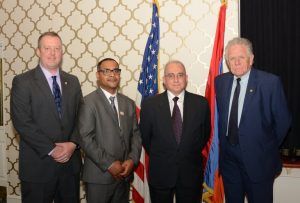Holy Resurrection Chapel of South Africa transferred to Armenian community

On January 13, King Msvati III of Swaziland has officially transferred the Holy Resurrection Armenian Chapel and the lands pertaining to the Chapel to the Catholicosate of Etchmiadzin, report Hayern Aysor’s sources.
A year ago, representatives of the local Armenian community submitted to King Msvati III of Swaziland a petition with the request to transfer the Holy Resurrection Church to the Catholicosate of Etchmiadzin.
A year later, the Armenian chapel of Swaziland truly became an Armenian chapel and one that will legally pertain to the Catholicosate from now on.
The Armenian church in the distant African kingdom was discovered in 1989, thanks to Grigor Derbelyan.
Grigor Derbelyan, citizen of Swaziland, was born in 1914 in Aintab. During the Armenian Genocide, with her 20-day-old son in her hands, Grigor’s mother reaches her husband in Cairo by foot and dies a couple of months later. Finishing his studies at the Armenian university in Cairo, for 12 years, Grigor works in Khartum (Sudan) where there was quite a large Armenian community. Later, he starts working for the Olivett company in Johannesburg, South African Republic.
When he matured, Grigor Derbelyan decides to settle in Swaziland where, according to him, he discovers a wonderful place called Pine Valley, which is not far from Mbaban, the capital of Swaziland. Seeing the place, Grigor decides that it is here where he wants to spend the rest of his life and die.
In the center of Pine Valley, the landscape of which reminded him of Armenia, Grigor purchases an 11-acre land, builds a small Armenian chapel and plants 1,770 pine and fir trees. A small river flows aside the chapel. Grigor refers to the river as the Arax River and even places a panel named “Arax River”. Construction of the church was launched in 1985 and ended in 1989.
About 60 people made contributions for construction of the chapel, including Olivetti Company, which hired Grigor for 12 years.
The small church has two cupolas.
Local construction materials were used to build the chapel. Interestingly, the part in the back of the chapel leans on a large stone that serves as an altar, like the Saint Geghard Church in Armenia.
Today, there is a small Armenian community of eight members in the small African Kingdom. The Armenians of the neighboring South African Republic help the Armenians of Swaziland care for the chapel and the lands pertaining to the chapel.




 Արևելահայերեն
Արևելահայերեն Արևմտահայերեն
Արևմտահայերեն Русский
Русский






